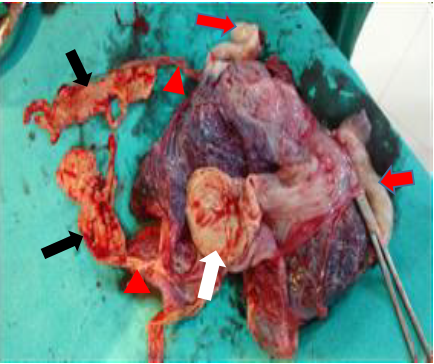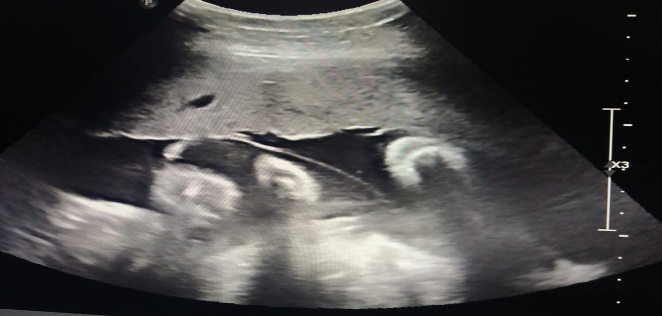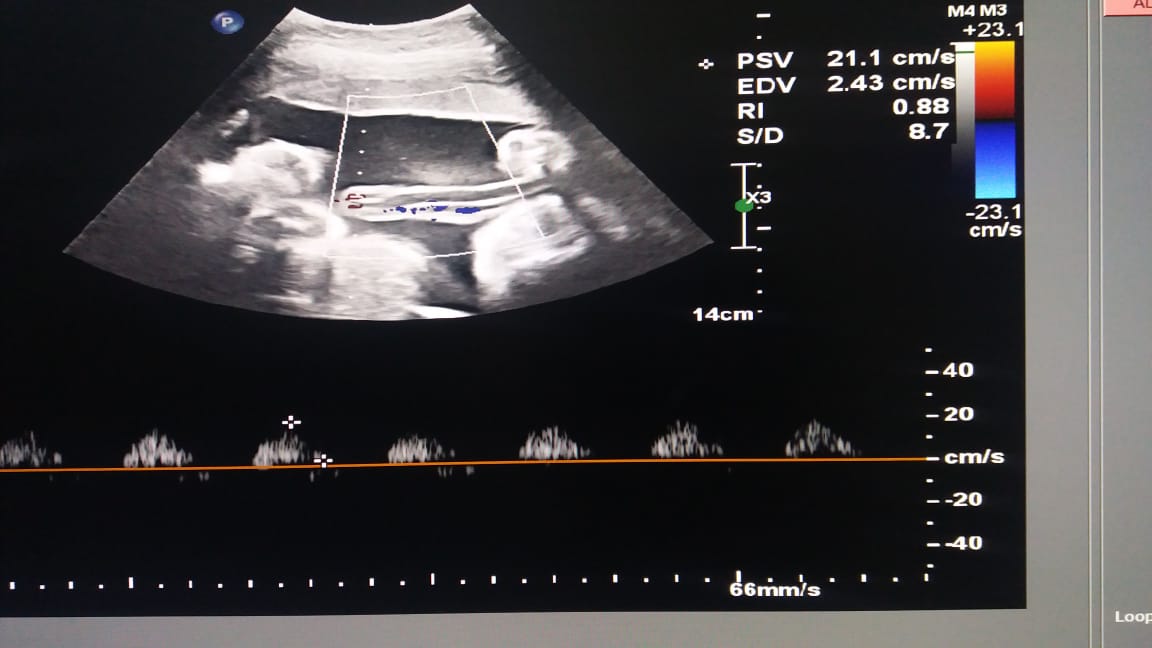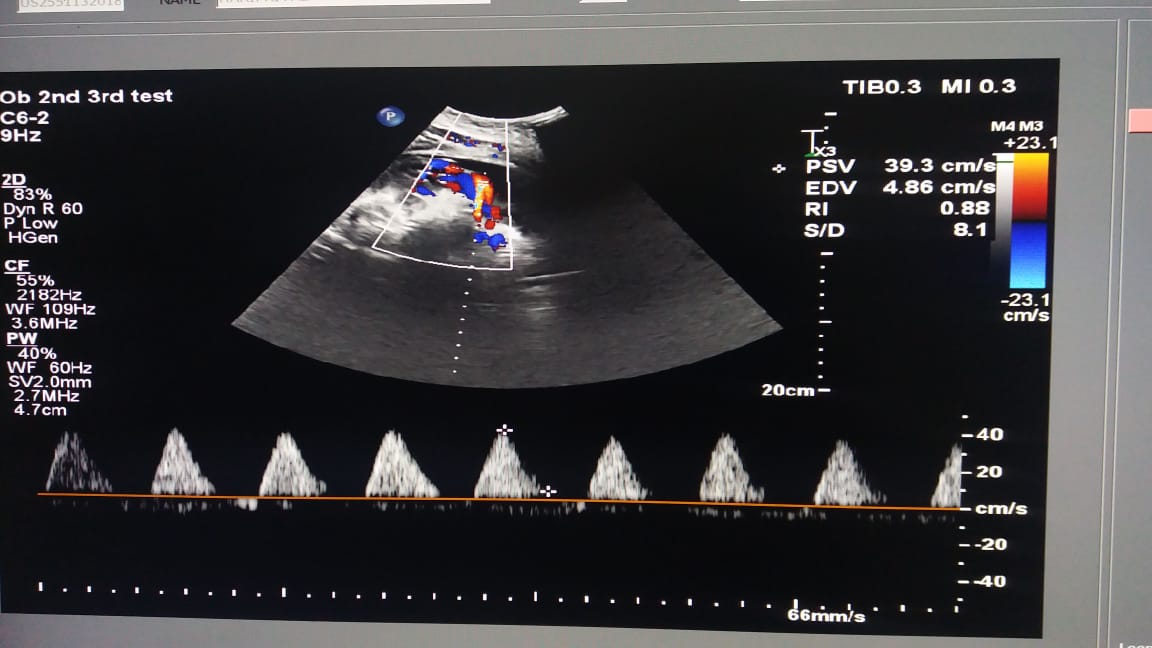Introduction
In recent times, with the increase in Assisted Reproductive Techniques the incidence of multiple pregnancies is rising, which in turn also increased incidence of fetal papyraceus. The reported incidence of fetus papyraceus is one in 12,000 pregnancies1 compared to 1:190 in twin pregnancies. Fetal papyraceus is a rare condition which is also called fetal compressus or vanishing twin syndrome where one of the fetuses is compressed mummified, parchment-like-state attached to placenta. It can be seen in Monozygotic or Dizygotic Twins, Ovulation induction or In vitro fertilization. It is associated with high morbidity and mortality to mother and fetus. Conditions associated with this which complicate the pregnancy are: Pre-eclampsia, Disseminated intravascular coagulation, Thrombotic thrombocytopenic purpura. The fetal life may be compromised due to prolonged second stage of labour, arrest of descent, hypoxia of second twin if not managed actively. Intrauterine complications effecting outcome of the pregnancy are premature babies, Low birth weight babies, Hypoxic ischemic encephalopathy.
Case
A 43-year-old Primigravida presented to our hospital at 29 weeks of gestation. She conceived through Artificial reproductive technique (In-vitro fertilization), done in other hospital. Her medical records suggest that fetal reduction was done at 13wks of gestation. Her first and second trimesters were uneventful. Her serial Ultrasounds showed diaminiotic and dichorionic twin pregnancies (Figure 1). In present ultrasound severe oligohydraminious (Amniotic fluid index was 2-3 for both fetuses) was noticed. On doppler there was early diastolic reversal in bilateral uterine arteries, with Utero-placental insufficiency (Figure 2, Figure 3) Due to uncertainty of the presenting part with arrested descent and oligohydraminious a decision was reached to deliver the fetus by Caesarean section. An emergency Caesarean section was done and a twin gestation with scanty liquor was noticed. Two male babies were delivered in cephalic and transverse presentation respectively with Apgar of 6 in first minute and 8 in fifth minute with separate placenta and membranes weighing 1.2kgs and 1kgs. Intraoperatively, there were three more fetuses attached to placenta were noted, two of which were without a cord approximately of 12 weeks and 9 weeks of gestation with atrophied placenta and calcifications, mummified fetal bones on the anterior to the lower segment of the uterus. A total of 5 fetuses were seen at different gestational ages (Figure 4). One unit of blood was transfused intraoperatively due to severe anemia prior to surgery. The mother was discharged home in stable condition on 5th post-operative day. In view of prematurity and very low birth weight, babies were shifted to Neonatal Intensive care unit for further management.
Figure 4
The picture shows the placenta with two healthy umbilical cord attachments. Three paper like compressed foetuses can be seen attached to the placenta with necrosed cords. The Black arrows shows the two fetusses of apprximately 13 wks of gestational age. The white arrows the foetus at 9 weeks of gestational age wrapped in the membranes. The red arrows shows the umblical cords of the live babies. The red arrow heads shows the necrosed attachments of the compressed fetusses.

Discussion
Fetal papyraceus is initially diagnosed sonographically by reduction in the number of gestational sacs in first trimester. The fetus can be like cyst, calcification, parchment like, underdeveloped fetus between membranes of placenta, partially developed fetus with absent cardiac activity and mummified bones.2 Depending on the gestational period at which fetal death occurs, there are three forms of this complication; vanishing twin syndrome in the first trimester, fetus papyraceus in the second trimester and the macerated twin in the third trimester.1 Different causes for the intra uterine death of one fetus include twin-twin transfusion syndrome, membranous or velamentous cord insertion, true cord knot, cord stricture, placental insufficiency, and congenital anomalies.3 Twin twin transfusion syndrome, in which thromboplastic substances from the dead twin are transferred to the survivor through communicating vascular channels within the placenta.4 The surviving co-twin is at risk of development of growth restriction, cerebral encephalomalacia and microcephaly. Diagnosis of Fetus papyraceus is very important to prevent further complications, plan the delivery of fetus and have successful surviving fetus outcome. Maternal consumptive coagulopathy due to fetal demise of one twin is a rarest reported complication.5, 6
Conclusions
The major concern for fetus papyraceus is its effect on the surviving fetus and on the mother. To prevent complications, the intrauterine diagnosis of fetus papyraceus by serial sonographic examinations and routine placental examination is mandatory. In most of the cases, no complications to the mother or surviving twin are observed and fetus papyraceus is mostly an incidental finding.





